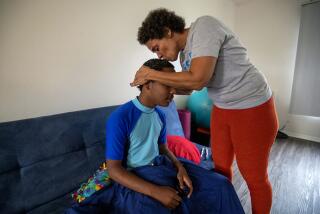When the Cardiologist’s Child Has a Damaged Heart
- Share via
Cardiologist Robert Gold was attending a seminar last summer on new strategies and treatments for heart failure at a conference center at the base of British Columbia’s coastal mountains. Accompanied by his wife, Kay, and teenage daughters, Rebecca, Jessica and Sarah, Gold hoped to also enjoy some family time in the picturesque village of Whistler, 90 miles north of Vancouver.
On Aug. 9, the Golds from Rockville, Md., decided to hike a steep trail, aiming for an apron of snow that lingered on a distant mountainside. Although they hiked for hours, they couldn’t quite reach the snow. When they returned to the hotel later that day, everyone was exhausted. But 14-year-old Sarah, the youngest of the girls, still had energy to take a swim before bed.
Just before dawn the next morning, Jessica awoke suddenly in the double bed she was sharing with Sarah. The two girls were in the loft of their hotel suite, with Rebecca and their parents sleeping below. The sound that woke Jessica came from Sarah, who was screaming and seemed to be gasping for air. Then the sounds abruptly stopped.
Jessica remembers thinking at first that Sarah was having a nightmare and had simply gone back to sleep. But her sister’s eyes were open and when Jessica tried to shake her awake, there was no response. Kay and Robert were awakened by Jessica’s hysterical voice: “Sarah, what’s wrong? Sarah, what’s wrong?”
Kay ran up to the loft and discovered that Sarah wasn’t breathing. She began screaming and instinctively, though ineffectively, started pumping on her daughter’s chest. Robert quickly followed, and the cardiologist realized their daughter was in full cardiac arrest.
He immediately began CPR, assisted by Kay. Rebecca ran to the phone and dialed 911. An ambulance with two emergency medical technicians arrived within 15 minutes. Using a defibrillator, they shocked Sarah’s heart into a normal rhythm and immediately felt a pulse. She began breathing on her own. Five minutes later, the emergency room doctor at the Whistler Health Care Center had given the girl oxygen and put her on a cardiac monitor. A helicopter was quickly requested to transport Sarah to British Columbia’s Children’s Hospital in Vancouver.
“The whole time we were at the clinic, I was saying, ‘This is a nightmare,’ Kay recalled. “And Robert was saying, ‘The nightmare hasn’t even begun.’ ”
Landing in Vancouver, Sarah was whisked to the intensive care unit. With Robert watching intently, pediatric cardiologist Michael Patterson conducted an echocardiogram, which uses sound waves to display the structures of the heart.
To his horror, it showed only the slightest quivering motion. Sarah’s heart was barely pumping enough blood to keep her alive.
“I stood there looking at the echo for a second or two, and turned away. My mind went blank,” Robert said. “I was devastated--Sarah had the worst heart of anyone I had ever seen in my practice. It just never occurred to me that this could happen to one of our children.”
The diagnosis: idiopathic dilated cardiomyopathy, a syndrome of unknown cause in which the heart becomes so large it cannot squeeze effectively enough to pump blood through the body.
In 80% to 90% of such cases, the cause remains unknown--that’s the “idiopathic” part of the name. The course of the disease is usually one of progressive deterioration, with as many as 50% of patients dying within five years, sometimes from the arrhythmia, or abnormal heartbeat, that Sarah experienced in her hotel bed.
Most of the patients Robert Gold sees with the disease are in their 50s and 60s; Sarah’s illness is exceedingly rare in a person her age. The definitive textbook on cardiovascular medicine states: “Children with dilated cardiomyopathy have a particularly grave prognosis.”
He Liked the Idea of
Fixing Broken Hearts
Born and raised in Baltimore, Robert Gold became the first doctor in his family when he graduated from the University of Maryland Medical School. The mechanics of the heart fascinated him and led to a cardiology fellowship at George Washington University, where he developed a sub-specialty in electrophysiology, the study of the organ’s electrical rhythms. Although much of cardiology involves managing chronic disease, Robert was intrigued that electrophysiology allowed him, on occasion, to literally fix broken hearts.
But Sarah’s illness seemed to him incurable. His dual role--as a physician who understood the condition and its implications only too well and as the father of the patient--weighed heavily. It was deeply disturbing to discover, he said, that “as a parent, there are things we just can’t do to help our children.” He had saved many patients’ lives. But he could not save his own daughter’s.
Worse, his professional background proved to be as much a burden as an aid. From the beginning of the episode, Robert’s extensive medical knowledge “made it much harder for me” to cope, he said. “I couldn’t fool myself when [various medical personnel] tried to comfort and reassure me that Sarah might get better. I had seen too much, known too many bad outcomes.”
Gradually, he was able to focus on what he could do to help Sarah: serve as an expert overseer of her medical care, standing watch at her hospital bed and later at home, monitoring tests, procedures and medications.
“I knew all the treatments she needed--I watched over their shoulders, keeping abreast of all that they were doing,” he said. “I had to make sure she was getting all the care available to her.” Being involved in this way, he says, “did make me feel a little less helpless.”
The family agreed with the Vancouver medical staff’s recommendation that if Sarah remained in stable condition, she should be transported home. Because Sarah would require extensive long-term care, the Golds’ insurance company had agreed to charter a jet to bring Sarah to Children’s National Medical Center in Washington, D.C. The plane had only enough room for the pilot, two emergency medical technicians and Robert.
The six-hour flight went without incident.
Sarah was put into the intensive care unit at Children’s. Kay, who had returned home on a commercial flight with the other two girls, arrived in the evening, when she first heard mention of the need for a heart transplant.
To her shock, the medical staff at Children’s already seemed to have concluded that a transplant was a necessity. For these experts, the question was not whether a transplant was required, but where the operation should be performed. While various procedures and medications may alleviate symptoms of cardiomyopathy, for some patients a heart transplant--with all its uncertainties and risks--is the only permanent “fix” for this heart condition.
Cardiomyopathy is the leading reason for heart transplants, of which 2,185 were performed in the United States during 1999.
For two weeks, Sarah remained at Children’s Hospital. She slept nearly all the time and remained extremely weak. After several days of evaluation, cardiologist Jeffrey Moak, Children’s director of electrophysiology, performed an ablation to help stabilize Sarah’s heart. In this procedure, the doctor uses a catheter to locate the site where the abnormal rhythm is originating. To prevent further arrhythmias, he then burns out that portion of the heart, using heat-generating, high-frequency radio waves.
Two days later, Moak implanted an automatic internal defibrillator. To adjust it, doctors must reproduce the potentially fatal arrhythmia and see if the device kicks in adequately to jump-start the muscle. Sarah’s heart required more electrical stimulation than her doctors expected. As a result, they had to induce a controlled cardiac arrest and shock her heart back into a normal rhythm 14 times to set the pacemaker-like device properly.
While Sarah was no longer in immediate danger, the gravity of her underlying condition remained.
Examinations Were Hard on Young Sarah
By this time, summer had ended. Sarah had been planning to start her first year of high school and was worried less about her health than about missing freshman orientation. But before that happened, Robert and Kay took her for a two-day evaluation at Children’s Hospital of Pittsburgh, a major transplant center that was relatively close to home. Sarah was still weak and very tired; going from one doctor to another, she found the examinations grueling.
Steven Webber, the hospital’s medical director of heart and lung transplantation, told the Golds that a heart transplant was indeed necessary. Sarah’s heart could not be fixed by surgery or medicine, and there appeared to be no other course of action if her condition worsened.
Kay vividly recalls Webber telling them that he had never seen a heart so enlarged in a person Sarah’s age. Webber, Robert said, “was very frank with us.” The transplant would be dangerous and careful follow-up care would be critical.
Sarah was put on the waiting list for a heart transplant; patients on this list must wait an average of six months before being matched with an available organ.
In early September, Sarah insisted on going to school, despite her parents’ misgivings. School administrators allowed Sarah to drop her first- and last-period classes. She was also given a key to the elevator and all her teachers were informed of her condition. Each day, she dragged herself to class and came home exhausted, where she collapsed on the sofa. Then, after a brief rest, “she was compulsive about doing her homework,” Kay recalled.
Robert spent a month at home helping to care for Sarah. “I never thought I could go back to (my office). I work with acutely ill patients with life-threatening illnesses. Sometimes I get upset when I tell patients about their arrhythmias and transplants,” Robert said.
“The only thing that helped is Sarah’s own attitude, which was so positive. She kept telling us not to keep worrying. Even with the specter of a heart transplant, Sarah was straightforward and matter-of-fact about it. She would say, ‘If I need it, I need it. I’ll get one and I’ll get better.’ She comforted us,” Robert explained.
Surprisingly, by January, echocardiograms began to show that Sarah’s heart was getting smaller. This gave her father some hope; he, perhaps more than anyone, had despaired of any improvement in his daughter’s condition. And her recovery continued. By March, her name was removed from the active transplant list. In early spring, she played basketball for the first time since the onset of her illness. Sarah beat her mom soundly. “She ran rings around me and then got out of breath and made me all nervous,” Kay reported.
Before the spring term ended, Sarah wasn’t complaining about being tired and didn’t have to lie down after school. And despite all that happened, she maintained straight As. She had wanted to join the track team, but competitive sports remained out of reach.
Careful medical care monitored assiduously by Robert--along with a dose of Sarah’s irrepressible optimism--may have helped create the environment for the teenager’s improvement to date. Still, questions linger about her long-term prognosis. “I’m optimistic,” says Moak. “She’s come a long way. Sarah has gotten a lot better, but it’s going to take a lot longer to know what the future may bring.”
And while Robert calls Sarah’s modest rebound “a miracle”--her heart is now functioning at 75% of its normal capacity--he is afraid to even consider making family vacation plans this year. Sarah, however, has no such qualms and expresses a keen desire to see Hawaii. “What she won’t do is go hiking. But I think she’ll be ready for that one of these days,” her father says.
Robert says the experience of caring for and witnessing the recovery of his daughter has made him feel closer to his patients. “I identify with them more,” he explained. And looking at medical care from the patient’s point of view has provided a reassuring view of his profession: “People complain about medical care, but everyone we encountered was wonderful--and it wasn’t just because I was a doctor. I watched how they were with other patients. I was surprised at how well it all worked.”
The cardiologist also had to come to terms with how some arbitrary facts made so much difference in Sarah’s case.
“The fact that we were on vacation, and Sarah and Jessie were sleeping in the same bed--if we had been at home, they would have been in separate rooms. It’s so random. What if it had happened the day before, on the hike? It would have taken hours to get to the road and hours more to bring back help,” he reflected. “We were lucky it happened when we were all together.”
On that August morning, while Sarah Gold’s father, mother and two sisters were desperately engaged in saving her life, a seminar had been scheduled for the cardiologists at the mountainside conference. The session Robert Gold missed was titled “Cardiac Transplantation: Lessons for Selection.”
More to Read
Sign up for Essential California
The most important California stories and recommendations in your inbox every morning.
You may occasionally receive promotional content from the Los Angeles Times.










